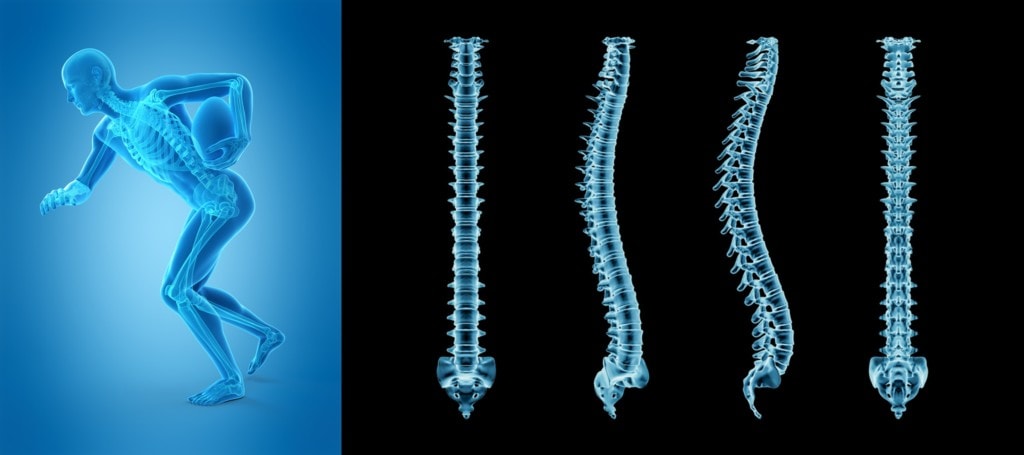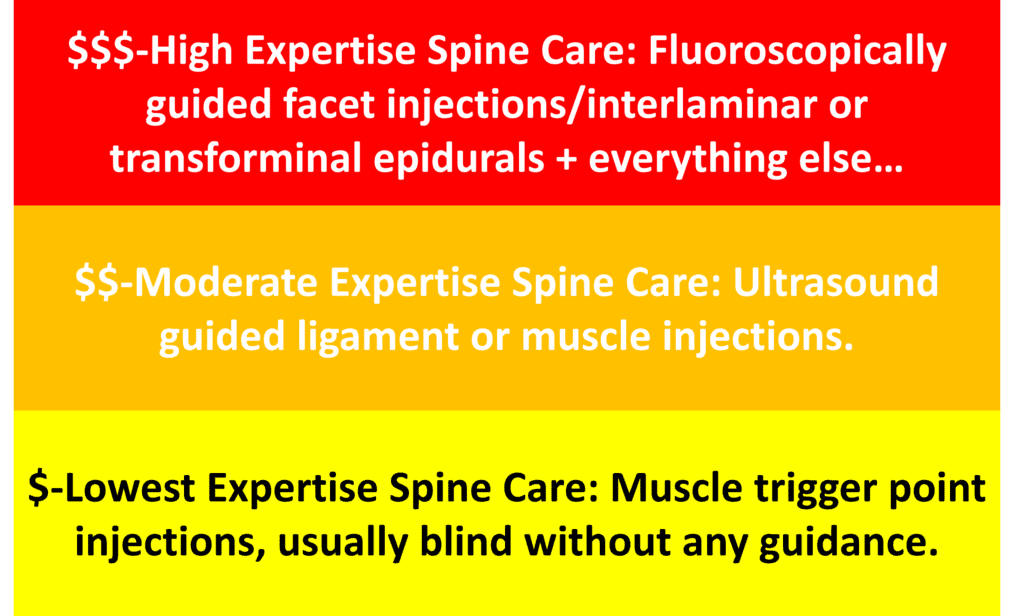Sports vs Spine: Understanding Levels of Regen Spine Care

One of the biggest problems in interventional orthobiologics is the dramatic differences between the levels of provider training and how that impacts what you get. While you may not know much about that, the goal here is to educate patients and appeal to my colleagues to provide full transparency. Let’s dig in.
Selling Procedures and Cars
Let’s say that we have a row of car dealerships selling new cars and that almost every make and model is represented. There are low-end cars, mid-range, and luxury vehicles. It’s pretty easy to see in that setting that you generally get what you pay for. For example, if you want to spend 20K, you’ll get a basic car. On the other end, if you spend 100K or more, you get all of the bells and whistles and can be surrounded by luxury. In this example, nobody would confuse a 20K Nissan Sentra with cloth seats and manual windows with a 130K Tesla Model S Plaid or a Maserati. If nothing else, the price differential itself will tell you what you need to know.
However, in the world of interventional orthobiologics, it’s strangely different. It’s as if the Nissan Sentra is priced at 100K and the Tesla Model S is priced at 50K. In addition, patients can’t see these differences as the details are hidden by the complexity of understanding medical procedures. Hence, our field desperately needs transparency about what you get when you plunk down your money.
An Example from this Week
A highly educated high-net-worth patient showed up at my Cayman clinic this week. He got a “PRP” injection in Miami from a doctor. He stated that his neck, shoulder, and elbow were injected to treat his right-hand numbness. Since he didn’t know exactly where he got injected, from asking questions, looking up the doctor online, and showing him a c-arm fluoroscope and ultrasound machine, I was able to deduce that he had the following areas treated in two separate treatment sessions:
- Neck muscle trigger point injections and ligaments
- Right shoulder sub-acromial bursa
- Right medial and lateral epicondyle
While this helped a bit (mostly with mild shoulder and elbow pain), he was still getting numbness and tingling down the arm and into his hand. So while he needs an MRI, based on my exam this is what he really needed:
- Right-sided lower cervical epidural (around irritated nerves) with platelet lysate
- Right ulnar nerve hydrodissection with platelet lysate
Here’s the rub. He didn’t go to a scam clinic. The doctor that injected him is board certified in family practice sports medicine. However, this guy paid big bucks for these injections and got the Nissan Sentra but needed the Tesla to produce results. He had no idea of the difference, which is a serious problem.
Why does he need nerves injected? He has a nerve problem. The issue is that the provider he went to isn’t trained to perform these more advanced procedures.
Sports vs Spine
While we’ll discuss other examples, let’s start with what happened here. The physician who injected him wasn’t trained in interventional spine, which is the use of x-ray guided procedures to access areas like the epidural space around the spinal nerves. However, based on his exam, this is what he needed (as well as a cervical MRI which was never done). Hence, the patient was unaware that he bought a super-expensive Nissan Sentra. Hence, he’s right back here getting a treatment that’s more likely to work, but he’ll end up paying a third time.
So right away, we see that we need some sort of system where a patient can decide what kind of doctor he’s seeing and how that will impact care options. For example, patients know I don’t perform neurosurgery, so if they want their back fused, most know that I’m not that guy. They can make these distinctions by looking at my board certification. However, they can’t make the same distinctions in going to providers who perform interventional orthobiologic procedures.
It Gets Much Worse
From an expertise standpoint, there’s an even bigger problem out there. Keeping with our auto sales analogy, I would call this the “clunker” space. Meaning instead of buying a hyper-expensive brand new Nissan Sentra, there are clinics offering a beat-up, old, low-end Chevy that sometimes doesn’t start and overheats easily for 100K. Let me explain.
In this clunker space are mismatched specialists (i.e. a urologist, cardiologist, or plastic surgeon) treating the spine or even worse a mid-level who isn’t a physician at all. They may offer injections into the muscles (trigger points) without any guidance or “blind”. Of all of the treatments this patient could get, this is likely to be the least effective.
How Do We Fix This?
We need transparency in interventional orthobiologics so people know what they’re getting. Forgetting about the quality of what’s injected, when it comes to the training and complexity of procedures, it would look something like this:

Hence, my patient was treated at the orange level, so he should have been charged less and understood that if this provider couldn’t help him, he would need more advanced procedures. Or if the patient was treated at a chiro or midlevel clinic, they should understand that they’re in the yellow level. This should cost the least and the patient needs to understand that only a fraction of the structures that could be injected can be injected at this low-level treatment site.
Will This Ever Happen?
It’s unlikely that we’ll ever see a scammy clinic run by midlevels in a chiropractic office in a strip mall admit that they offer low-level care. However, I do think it’s possible to get the legit orthopedic or sports medicine clinics to admit to patients that they are unable to offer more advanced spinal procedures. Had that been explained to my patient, we wouldn’t have had to spend 10 minutes playing charades trying to figure out what he had and what he needed. In addition, my patient would have been told what he needed next if the simple spine PRP injections didn’t work. He also would have had the option of saying, “no thanks”, I’ll start with someone who can do the more advanced stuff.
The upshot? We need transparency in interventional orthobiologics so that patients can avoid paying 100K for a Nissan Sentra with cloth seats. On the legit side of the field, it’s time to help patients understand how much they’re paying for which level of care.

If you have questions or comments about this blog post, please email us at [email protected]
NOTE: This blog post provides general information to help the reader better understand regenerative medicine, musculoskeletal health, and related subjects. All content provided in this blog, website, or any linked materials, including text, graphics, images, patient profiles, outcomes, and information, are not intended and should not be considered or used as a substitute for medical advice, diagnosis, or treatment. Please always consult with a professional and certified healthcare provider to discuss if a treatment is right for you.
